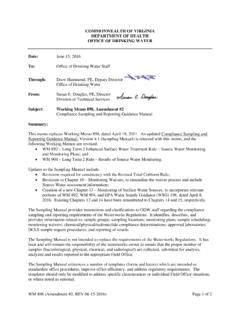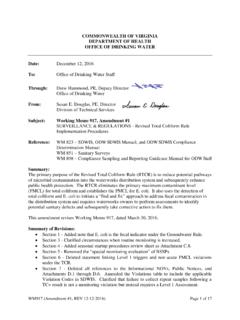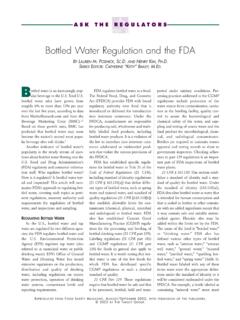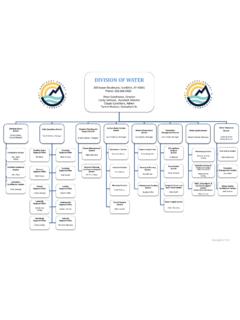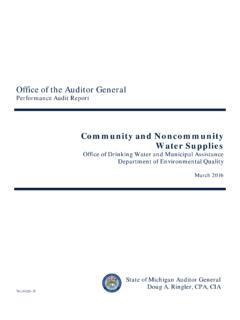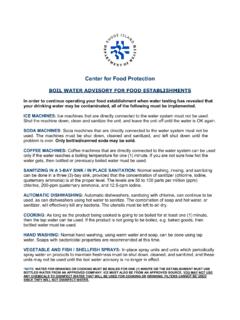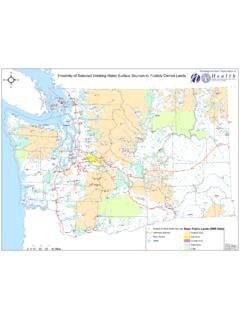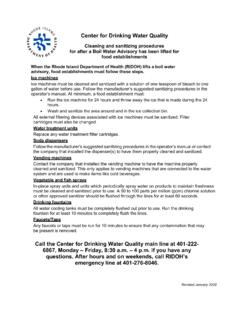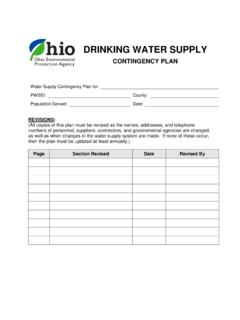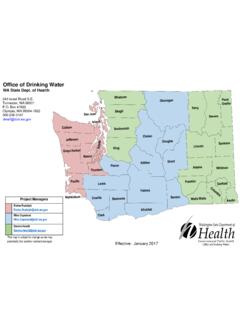Transcription of in Drinking Water - OEHHA | Office of Environmental Health ...
1 DRAFT For Review Only Public Health Goal for Bromate in Drinking Water Prepared by Pesticide and Environmental Toxicology Branch Office of Environmental Health Hazard Assessment California Environmental Protection Agency May 2009 DRAFT DRAFT FOR PUBLIC COMMENT AND SCIENTIFIC REVIEW ii May 2009 PREFACE Drinking Water Public Health Goal Pesticide and Environmental Toxicology Branch Office of Environmental Health Hazard Assessment California Environmental Protection Agency This Public Health Goal (PHG) technical support document provides information on Health effects from contaminants in Drinking Water . PHGs are developed for chemical contaminants based on the best available toxicological data in the scientific literature. These documents and the analyses contained in them provide estimates of the levels of contaminants in Drinking Water that would pose no significant Health risk to individuals consuming the Water on a daily basis over a lifetime.
2 The California Safe Drinking Water Act of 1996 ( Health and Safety Code, Section 116365) requires the Office of Environmental Health Hazard Assessment ( OEHHA ) to perform risk assessments and adopt PHGs for contaminants in Drinking Water based exclusively on public Health considerations. The Act requires that PHGs be set in accordance with the following criteria: 1. PHGs for acutely toxic substances shall be set at levels at which no known or anticipated adverse effects on Health will occur, with an adequate margin of safety. 2. PHGs for carcinogens or other substances that may cause chronic disease shall be based solely on Health effects and shall be set at levels that OEHHA has determined do not pose any significant risk to Health . 3. To the extent the information is available, OEHHA shall consider possible synergistic effects resulting from exposure to two or more contaminants. 4. OEHHA shall consider potential adverse effects on members of subgroups that comprise a meaningful proportion of the population, including but not limited to infants, children, pregnant women, the elderly, and individuals with a history of serious illness.
3 5. OEHHA shall consider the contaminant exposure and body burden levels that alter physiological function or structure in a manner that may significantly increase the risk of illness. 6. OEHHA shall consider additive effects of exposure to contaminants in media other than Drinking Water , including food and air, and the resulting body burden. 7. In risk assessments that involve infants and children, OEHHA shall specifically assess exposure patterns, special susceptibility, multiple contaminants with toxic mechanisms in common, and the interactions of such contaminants. DRAFT DRAFT FOR PUBLIC COMMENT AND SCIENTIFIC REVIEW iii May 2009 8. In cases of insufficient data for OEHHA to determine a level that creates no significant risk, OEHHA shall set the PHG at a level that is protective of public Health with an adequate margin of safety. 9. In cases where scientific evidence demonstrates that a safe dose response threshold for a contaminant exists, then the PHG should be set at that threshold.
4 10. The PHG may be set at zero if necessary to satisfy the requirements listed above in items seven and eight. 11. PHGs adopted by OEHHA shall be reviewed at least once every five years and revised as necessary based on the availability of new scientific data. PHGs adopted by OEHHA are for use by the California Department of Public Health (DPH) in establishing primary Drinking Water standards (State Maximum Contaminant Levels, or MCLs). Whereas PHGs are to be based solely on scientific and public Health considerations without regard to economic cost considerations or technical feasibility, Drinking Water standards adopted by DPH are to consider economic factors and technical feasibility. Each primary Drinking Water standard adopted by DPH shall be set at a level that is as close as feasible to the corresponding PHG, placing emphasis on the protection of public Health . PHGs established by OEHHA are not regulatory in nature and represent only non-mandatory goals.
5 By state and federal law, MCLs established by DPH must be at least as stringent as the federal MCL, if one exists. PHG documents are used to provide technical assistance to DPH, and they are also informative reference materials for federal, state and local public Health officials and the public. While the PHGs are calculated for single chemicals only, they may, if the information is available, address hazards associated with the interactions of contaminants in mixtures. Further, PHGs are derived for Drinking Water only and are not intended to be utilized as target levels for the contamination of other Environmental media. Additional information on PHGs can be obtained at the OEHHA Web site at DRAFT DRAFT FOR PUBLIC COMMENT AND SCIENTIFIC REVIEW iv May 2009 LIST OF CONTRIBUTORS PHG PROJECT MANAGEMENT REPORT PREPARATION SUPPORT Project Director Authors Administrative Support Anna Fan, Tom Parker, Hermelinda Jimenez Patty Wong, Michael Baes Lindsey Roth, Janet Rennert PHG Program Leader Robert A.
6 Howd, Primary Reviewers Library Support Sara Hoover, Charleen Kubota, Comment Coordinator Web site Posting Michael Baes Final Reviewers Laurie Monserrat Anna Fan, George Alexeeff, Robert Howd, DRAFT DRAFT FOR PUBLIC COMMENT AND SCIENTIFIC REVIEW v May 2009 TABLE OF CONTENTS PREFACE .. II LIST OF CONTRIBUTORS .. IV TABLE OF CONTENTS .. V PUBLIC Health GOAL FOR BROMATE IN Drinking Water ..1 SUMMARY ..1 INTRODUCTION ..1 CHEMICAL PROFILE ..2 Chemical Identity ..2 Physical and Chemical Properties ..3 Production and Uses ..3 Environmental OCCURRENCE AND HUMAN EXPOSURE ..4 Air ..4 Soil ..4 Water ..4 Food ..5 Other Sources ..6 Cosmetic Use ..6 METABOLISM AND PHARMACOKINETICS ..6 Absorption ..6 Distribution ..8 Metabolism ..8 Excretion ..8 Physiological/Nutritional Role ..9 TOXICOLOGY ..9 Toxicological Effects in Animals and Plants ..9 Acute Toxicity ..9 Subchronic Toxicity ..10 Genetic Toxicity ..10 Developmental and Reproductive Toxicity.
7 14 Immunotoxicity ..15 DRAFT DRAFT FOR PUBLIC COMMENT AND SCIENTIFIC REVIEW vi May 2009 Neurotoxicity ..15 Chronic Toxicity ..16 Carcinogenicity ..19 Toxicological Effects in Humans ..23 Acute Toxicity ..23 Genetic toxicity ..23 Chronic Toxicity ..24 Neurotoxicity ..24 Other Toxic Effects in Humans ..25 DOSE-RESPONSE Noncancer Effects ..25 Carcinogenic Effects ..25 Overview of Time-to-Tumor and Multi-Site Analyses ..25 DeAngelo Data Set ..26 Methods ..28 Discussion ..31 CALCULATION OF PHG ..32 Noncancer Effects ..32 Carcinogenic Effects ..33 RISK CHARACTERIZATION ..34 OTHER REGULATORY STANDARDS ..35 REFERENCES ..37 APPENDIX ..44 DRAFT DRAFT FOR PUBLIC COMMENT AND SCIENTIFIC REVIEW 1 May 2009 PUBLIC Health GOAL FOR BROMATE IN Drinking Water SUMMARY The Office of Environmental Health Hazard Assessment ( OEHHA ) proposes a Public Health Goal (PHG) of parts per billion (ppb) for bromate in Drinking Water , based on its carcinogenicity.
8 Bromate can be found in Drinking Water as a byproduct of the ozonation disinfection process. Although bromate has a long history of use as a food additive [at levels up to 75 parts per million (ppm) in flour], it is largely converted to bromide in the baking process. Bromate is a strong oxidant and is chemically reactive. It is mutagenic and has caused cancer in multiple organs in rodent bioassays. The proposed PHG is based on a study by DeAngelo et al. (1998) in which the authors related cancer in male F344 rats to lifetime exposure to bromate in their Drinking Water at daily doses from to mg/kg-day. A cancer potency estimate of (mg/kg-day)-1 is used, derived by a time-to-tumor multi-site approach based on the tumor data for mesothelioma, kidney tumors and thyroid tumors in the male rat, which was the sex and species observed to be most susceptible to the carcinogenic effects of bromate. Non-cancer adverse effects were found in several studies, and OEHHA also selected the male rat data in the DeAngelo et al.
9 (1998) study for determination of an acceptable daily dose (ADD). The noncancer No Observed Adverse Effect Level (NOAEL) is mg/kg-day of bromate, based on renal pelvis urothelial hyperplasia in male rats. Using a relative source contribution (RSC) of , a total uncertainty factor (UF) of 100 for inter- and intra-species differences, and a daily Water consumption rate of L/kg-day, an ADD of mg/kg-day and a Health -protective value of 50 ppb are derived based on the noncancer endpoint. The Environmental Protection Agency ( EPA) Maximum Contaminant Level Goal (MCLG) for bromate is set at zero, based on carcinogenicity. The Maximum Contaminant Level (MCL) is set at 10 ppb, based on the practical quantification limit ( EPA, 1998). Since May 31, 2002, bromate has been listed as a chemical known to the State of California to cause cancer. It was listed under Proposition 65 using the authoritative bodies mechanism. The listing was based on the EPA classification of bromate as a probable human carcinogen (Group B2) with sufficient evidence of carcinogenicity in experimental animals.
10 INTRODUCTION Bromate (BrO3-) is a negatively charged polyatomic ion containing one bromine and three oxygen atoms. Typical salts of bromate are potassium bromate (KBrO3) and sodium bromate (NaBrO3). In 1998, the EPA published an MCL of mg/L and an MCLG of zero mg/L for bromate in Drinking Water , based on a weight of evidence evaluation of both cancer (multiple sites, both sexes, rats) and noncancer effects. Bromate, as the potassium salt, is listed as a Group 2B possible human carcinogen by the International Agency for Research on Cancer (IARC). Bromate was shown to be mutagenic via in vitro and in vivo studies. In rats, long-term exposure to bromate in DRAFT DRAFT FOR PUBLIC COMMENT AND SCIENTIFIC REVIEW 2 May 2009 Drinking Water yielded adverse thyroid and kidney effects and inhibited body weight gain. Human exposure to bromate occurs in several ways. Bromate salts have been used as a food ingredient, being added to beer and cheese, and also used as a neutralizing agent for permanent wave hair styling products (Dupuis, 1997; IPCS, 2006).










